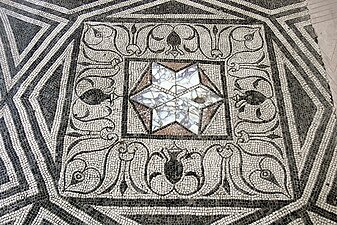Opus sectile
This article includes a list of general references, but it remains largely unverified because it lacks sufficient corresponding inline citations. (August 2013) |

Opus sectile is an art technique popularized in the ancient and medieval Roman world where materials were cut and inlaid into walls and floors to make a picture or pattern. Common materials were marble, mother of pearl, and glass. The materials were cut in thin pieces, polished, then trimmed further according to a chosen pattern. Unlike tessellated mosaic techniques, where the placement of very small uniformly sized pieces forms a picture, opus sectile pieces are much larger and can be shaped to define large parts of the design.
Origin and evolution[]
Early examples[]
Early examples have been found from Egypt and Asia Minor.[citation needed]
The Herodian Temple in Jerusalem was built during the second half of the 1st century BCE and the first half of the 1st century CE. Recent work by the Temple Mount Sifting Project has recovered enough pieces of floor tile from the Herodian Temple Mount to reconstruct geometric patterns of opus sectile flooring.[1]
Golden era: Rome and Eastern Empire[]

The most prominent artifacts remain from 4th-century Rome. A large set from the Basilica of Junius Bassus survived, depicting an elaborate chariot and other images.[citation needed] The popularity of opus sectile decoration continued in Rome through the 6th century, and affected areas as far as Constantinople (now Istanbul in Turkey). Particularly remarkable are a series of fourth-century CE panels in glass opus sectile, found in a possible sanctuary of Isis at the eastern Corinthian port of Kenchreai, in excavations carried out in the 1960s; they include scenes of famous authors like Homer and Plato, scenes of Nilotic landscapes, harbour-front cities and geometric panels.[citation needed]
Examples[]

Marble floor inlay, Hadrian's Villa (early 2nd century)

Vegetal pattern. Roman artwork, 2nd century CE, possibly from the villa of Lucius Verus in . On exhibit at the Palazzo Massimi alle Terme

Ancient Roman star-shaped opus sectile inset within a tessellated (i.e. mosaic) pavement (Archaeological Museum, Aquileia)
Later uses[]
Byzantine Empire[]
Although the technique died in Rome with the decline of the Empire, it continued to be used prominently in Byzantine churches, primarily in floor designs.[citation needed]
Medieval Italy[]

From Byzantium it was eventually brought back to Sicily and the Italian mainland, in the 12th century as the Cosmatesque style, concentrating on geometric patterns.[citation needed]
Italian Renaissance[]
There was a major revival from the Italian Renaissance (14th–17th century) in the form of pietra dura work, although this normally consists of much smaller compositions and it is used on furniture, mainly.[citation needed]
Intarsia[]
Architectural work from later periods tends to be called intarsia.[citation needed]
19th-century England[]
In England, the technique was revived in the late 19th century by artists working in the Arts and Crafts movement. Charles Hardgrave, whose designs were executed by James Powell & Sons at the Whitefriars Glass Works, was a noted designer in this technique.[citation needed]
See also[]
| Wikimedia Commons has media related to Opus sectile. |
- Cosmatesque (opus alexandrinum)
- Intarsia
- Marquetry
- Opus incertum – Ancient Roman masonry using irregular stones in a core of concrete
- Opus mixtum, also known as Opus compositum – Combination of Roman construction techniques
- Opus quadratum – Roman masonry using parallel courses of squared stone of the same height
- Pietra dura
- Roman concrete, also known as Opus caementicium – Building material used in ancient Rome
Bibliography[]
- Avraham, A.: 'Addressing the Issue of Temple Mount Pavements During the Herodian Period'. New Studies on Jerusalem, Vol 13, Ramat-Gan, Israel. 2007.
- De Fazio, A & Schöps, A.: Un lacerto in 'opus sectile' dalla 'domus' di via D'Azeglio a Ravenna: proposte di restauro e conservazione. Ravenna: Longo, 1995.
- Snyder, F. & Avraham. A.: The Opus Sectile Floor in Caldarium of the Palatial Fortress at Cypros. In: Hasmonean and Herodian Palaces at Jericho, Volume V. The Hebrew University of Jerusalem, pp 175–202. 2013.
- The Stations of the Cross according to St. Alphonsus; reproduced from the original “opus sectile” panels in the Church of St Mary's, Lowe House, St Helens, Lancs. London: Burns Oates, 1934.
References[]
- ^ Frankie Snyder, Gabriel Barkay and Zachi Dvira. 2016. Biblical Archaeology Review, November/December.
- ^ Katherine M.D. Dunbabin, "The Victorious Charioteer on Mosaics and Related Monuments," American Journal of Archaeology 86.1 (1982), p. 71.
- James, Liz. "Opus sectile". Grove Art Online. Oxford University Press.
- Artistic techniques
- Ancient Roman art
- Hardstone carving
- Roman mosaics



